Key Takeaways
- Optimizing your LinkedIn profile is essential for attracting top talent to your organization.
- Recruiting passive candidates through LinkedIn can expand your talent pool and lead to successful hires.
- Utilizing LinkedIn Recruiter and tracking and measuring success are key strategies for optimizing your recruitment efforts on LinkedIn.
Welcome to this comprehensive guide on how to effectively recruit on LinkedIn, one of the world’s largest professional networking platforms.
LinkedIn boasts over 900 million members in more than 200 countries and territories, making it an essential tool for recruiters and hiring managers looking to expand their talent pool and connect with top candidates.

In today’s competitive job market, it’s crucial to have a strong recruiting strategy in place, and LinkedIn offers a unique opportunity to connect with both active and passive job seekers.
By using the right techniques and tools, recruiters can target their ideal candidates, build relationships with potential hires, and ultimately fill positions with top talent.
However, simply creating a LinkedIn profile and posting job openings is not enough to attract the best candidates.
To truly stand out and succeed in recruiting on LinkedIn, you need to have a comprehensive understanding of the platform’s features, best practices, and optimization strategies.
That’s why we’ve put together this guide, which will provide you with ten top strategies to help you recruit effectively on LinkedIn.
We’ll cover everything from optimizing your profile to attract the right candidates, posting job openings in a way that reaches the right audience, and leveraging employee networks to find the best talent.
We’ll also cover advanced strategies, such as using LinkedIn Recruiter to search for and reach out to passive candidates, and measuring your success with key performance indicators (KPIs) and data analysis.
With these strategies in place, you can build a strong recruitment presence on LinkedIn and attract the best candidates for your organization.
So whether you’re a seasoned recruiter or new to LinkedIn recruiting, this guide will provide you with the knowledge and tools you need to succeed. Let’s get started with the first strategy: optimizing your LinkedIn profile for recruitment.
Before we venture further into this article, we like to share who we are and what we do.
About Jobsrefer
Jobsrefer is a Human Resource Technology (HRTech) startup based in Singapore, Vietnam and Indonesia with a strong presence worldwide.
Jobsrefer is a de-centralised referral platform helping thousands of recruiters and referrers earn a side income and affiliate commission referring their network to jobs.
If your company needs also need a platform that accelerate HR and Recruitment services, you can use Jobsrefer headhunting and recruitment and EOR services to hire top tech talents and candidates worldwide. Book a consultation slot here, or send over an email to [email protected]
How to Recruit on LinkedIn: 10 Top Strategies (Updated in 2023)
- Optimizing your LinkedIn profile for Recruitment
- Posting Job Openings on LinkedIn
- Utilizing LinkedIn Groups
- Recruiting Passive Candidates on LinkedIn
- Using LinkedIn Recruiter
- Leveraging Employee Networks
- Showcasing Company Culture on LinkedIn
- Tracking and Measuring Success
- Understanding your Competitors
- Use Boolean search to find candidate LinkedIn profiles
1. Optimizing your LinkedIn profile for Recruitment
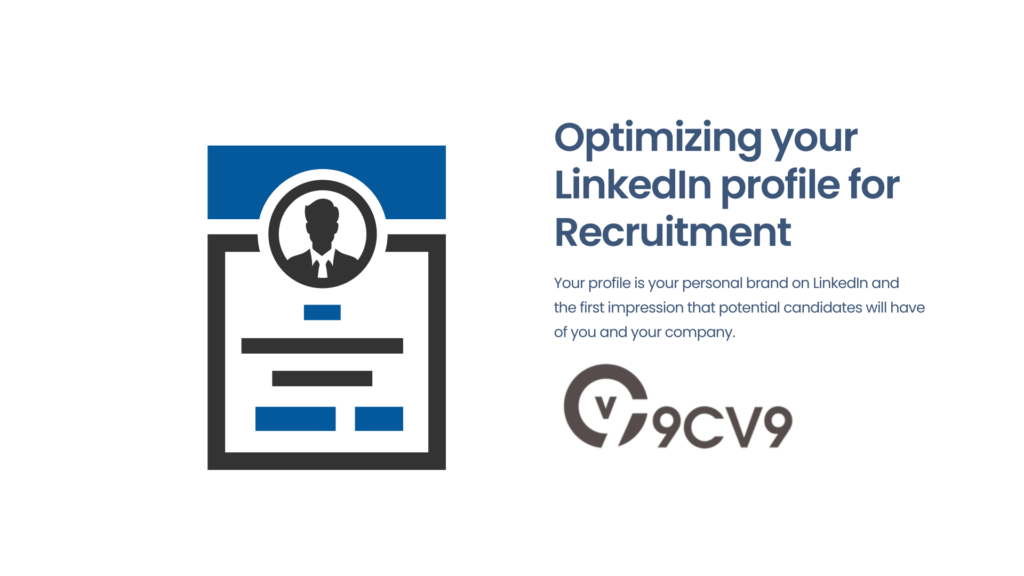
Optimizing your LinkedIn profile is crucial for successful recruitment on the platform.
Your profile is your personal brand on LinkedIn and the first impression that potential candidates will have of you and your company.
By following these strategies, you can make your profile stand out, attract the right candidates, and ultimately fill positions with top talent.
- Creating an effective LinkedIn profile Your LinkedIn profile should showcase your professional experience, skills, and accomplishments. Make sure that your profile picture is professional and that your headline accurately describes your role and expertise. Your summary should provide a brief overview of your background and highlight your accomplishments, skills, and values. Be sure to also include your contact information and any relevant links, such as your company’s website or social media accounts.
- Highlighting your company’s culture and values Your LinkedIn profile should also reflect your company’s culture and values. Consider including information about your company’s mission statement, values, and culture in your summary or experience section. This can help attract candidates who share your company’s values and are more likely to thrive in your organization’s culture.
- Showcasing job openings and opportunities Make it clear on your LinkedIn profile that your organization is hiring by posting job openings and opportunities on your profile. You can add job postings to your experience section or create a separate job postings section. Be sure to include a link to the job posting on your company’s website or career page to make it easy for candidates to apply.
- Utilizing LinkedIn’s recruiting features LinkedIn offers several features specifically designed for recruiters, such as the Recruiter Lite or Recruiter Professional services. These tools provide advanced search options, messaging capabilities, and analytics to help you find and engage with potential candidates. Consider investing in these tools to make the most of your recruitment efforts on LinkedIn.
By following these strategies, you can optimize your LinkedIn profile for recruitment and attract the right candidates for your organization.
A strong profile can help you build your personal brand, showcase your company’s culture and values, and promote your job opportunities to potential candidates.
Or you can get 9cv9 Job Posting Portal for more effective hiring and recruitment.
Next, let’s look at how to post job openings on LinkedIn effectively.
2. Posting Job Openings on LinkedIn
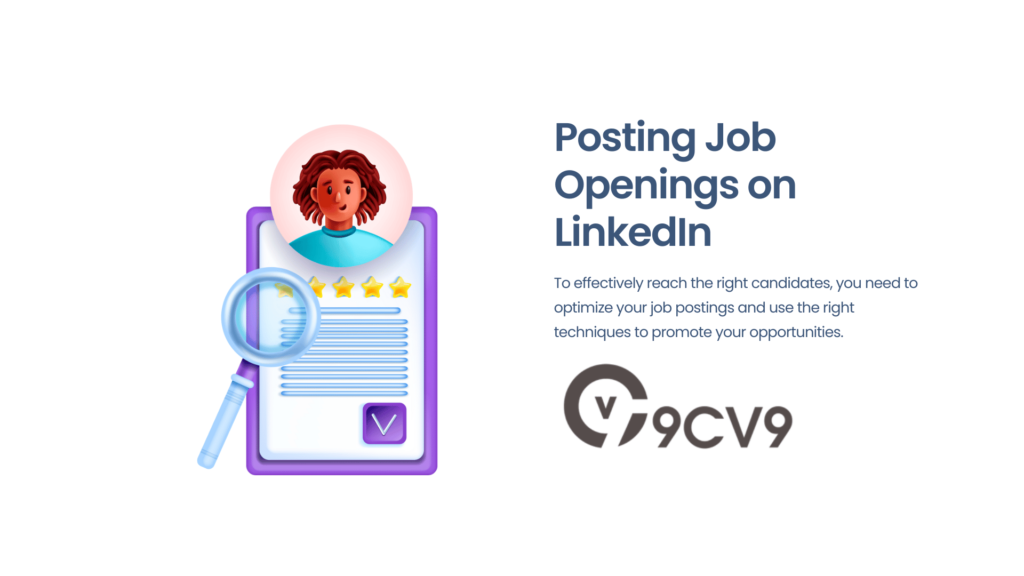
Posting job openings on LinkedIn is a key strategy for attracting top talent to your organization.
However, simply posting a job listing is not enough to stand out in the crowded job market.
To effectively reach the right candidates, you need to optimize your job postings and use the right techniques to promote your opportunities.
Here are some strategies to help you post job openings on LinkedIn effectively:
- Write a compelling job description Your job description should be clear, concise, and engaging. Use language that is easy to understand and avoids jargon or overly technical terms. Highlight the most important skills and qualifications required for the job, and provide information about the company culture and benefits.
- Use relevant keywords Make sure to use relevant keywords in your job description, as this will help your listing show up in search results for potential candidates. Use industry-specific terms, job titles, and key skills in your description. You can also use LinkedIn’s job posting optimization tool to suggest relevant keywords and improve the visibility of your job listing.
- Target the right audience LinkedIn allows you to target your job postings to specific groups of people based on factors such as location, job title, and industry. This can help you reach the right candidates and increase the chances of finding the right fit for your organization. Be sure to also consider promoting your job posting on LinkedIn groups and relevant social media platforms.
- Encourage employee referrals Employee referrals are a powerful way to find top talent, and LinkedIn makes it easy to encourage your employees to refer their network. You can create a referral program and offer incentives for successful referrals. Additionally, you can leverage LinkedIn’s referral feature, which allows you to ask employees to recommend potential candidates directly on the platform.
- Use LinkedIn’s job posting analytics LinkedIn provides analytics for job postings, allowing you to track the performance of your listing and make adjustments to improve your results. Use these analytics to track the number of views and applications, as well as the demographics of the candidates who are viewing your job posting. This can help you make informed decisions about your recruitment strategy and adjust your approach as needed.
By following these strategies, you can effectively post job openings on LinkedIn and attract the right candidates for your organization.
Similarly, 4,500+ employers all over the world use 9cv9 Job Portal to post jobs for free.
A compelling job description, targeted audience, and strategic use of keywords and analytics can help you stand out in the competitive job market and find the best talent for your team.
3. Utilizing LinkedIn Groups
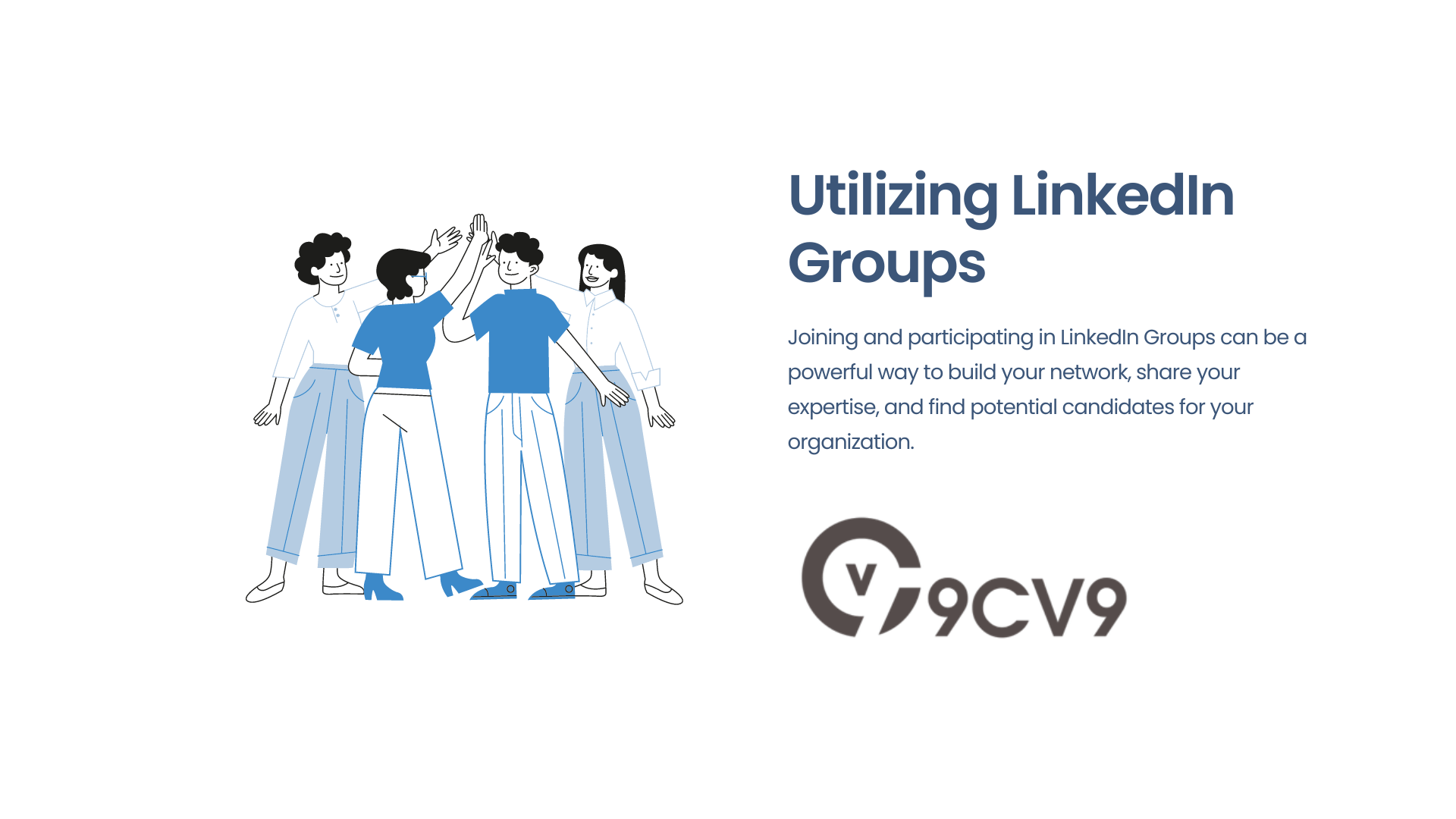
LinkedIn Groups are online communities of professionals who share common interests, backgrounds, or goals.
Joining and participating in LinkedIn Groups can be a powerful way to build your network, share your expertise, and find potential candidates for your organization.
Here are some strategies to help you effectively utilize LinkedIn Groups for recruitment:
- Join relevant groups Start by identifying groups that are relevant to your industry, job function, or target audience. Look for groups with active discussions and a large number of members. You can use LinkedIn’s search function to find groups or explore recommendations based on your profile and interests.
- Engage with group members Once you have joined a group, participate in discussions, share your expertise, and engage with other members. This can help you build relationships and establish yourself as a thought leader in your field. Be sure to also follow up with potential candidates who show interest in your organization or job openings.
- Share job openings LinkedIn Groups provide a targeted audience for promoting your job openings. However, it’s important to be strategic in your approach. Avoid spamming the group with job listings, and instead focus on sharing relevant opportunities that align with the group’s interests and needs. You can also ask group members for referrals or recommendations for potential candidates.
- Create your own group If you can’t find a relevant group to join, consider creating your own. This can be a powerful way to establish yourself as a leader in your field, build your network, and attract potential candidates to your organization. Be sure to promote your group through other channels, such as your LinkedIn profile, email marketing, or social media.
- Leverage LinkedIn Group analytics LinkedIn provides analytics for groups, allowing you to track the performance of your group and make adjustments to improve your results. Use these analytics to track the number of members, engagement, and demographics of the group. This can help you make informed decisions about your recruitment strategy and adjust your approach as needed.
By utilizing LinkedIn Groups effectively, you can expand your network, build your personal brand, and find potential candidates for your organization.
Engaging with group members, sharing job openings strategically, and creating your own group can help you establish yourself as a thought leader and attract top talent to your team.
4. Recruiting Passive Candidates on LinkedIn
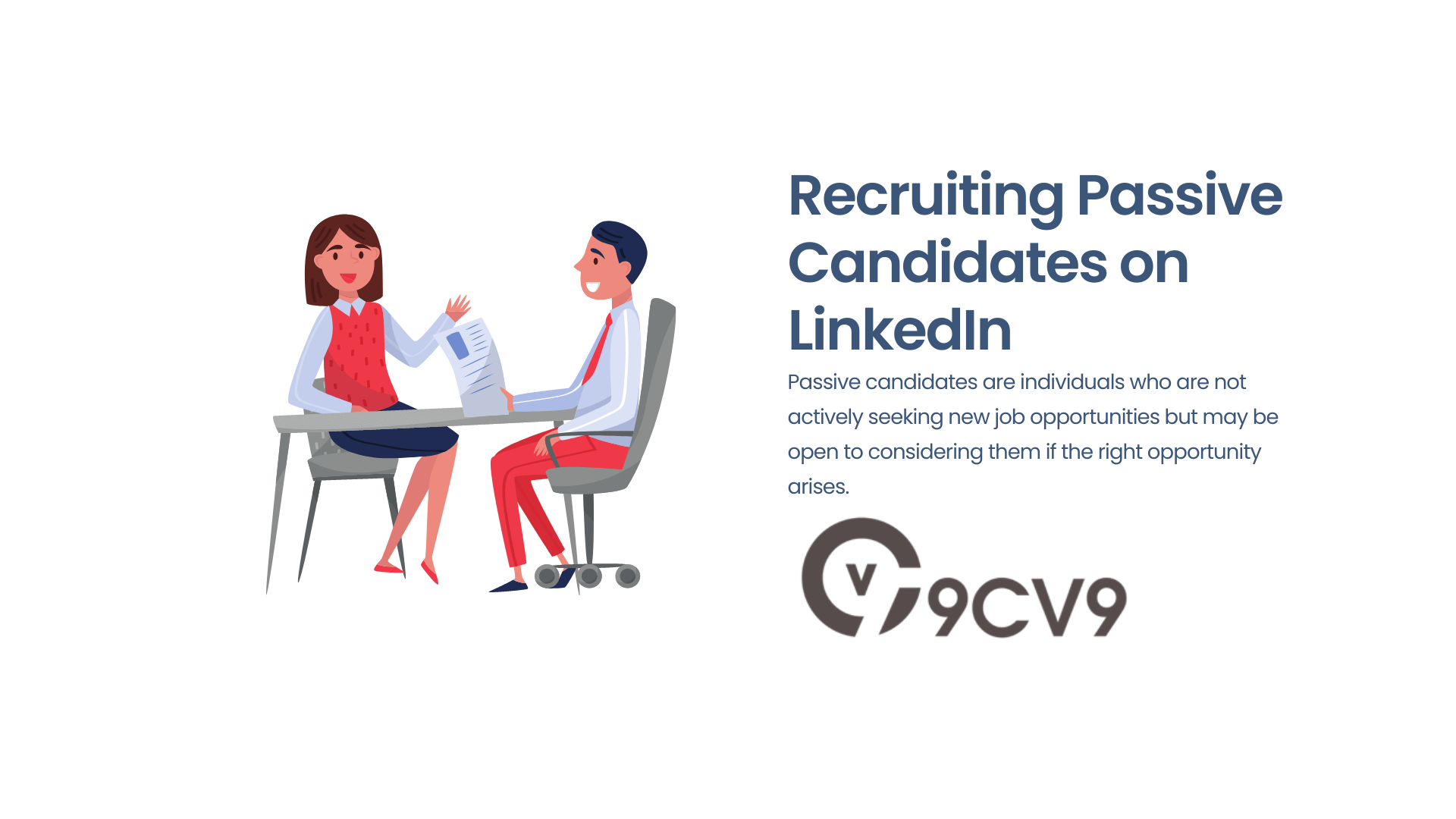
Recruiting passive candidates on LinkedIn can be a highly effective way to find top talent for your organization.
Passive candidates are individuals who are not actively seeking new job opportunities but may be open to considering them if the right opportunity arises.
Here are some strategies to help you effectively recruit passive candidates on LinkedIn:
- Build your personal brand One of the most effective ways to attract passive candidates is to build your personal brand on LinkedIn. This means establishing yourself as a thought leader in your industry, sharing valuable insights and resources, and engaging with other professionals. By building a strong personal brand, you can attract passive candidates who are interested in working with a reputable and respected professional.
- Use advanced search tools LinkedIn’s advanced search tools allow you to filter by a wide range of criteria, including job title, location, industry, and company size. Use these tools to identify potential candidates who match your ideal profile, even if they are not actively looking for new opportunities.
- Reach out with personalized messages When reaching out to passive candidates, it’s important to personalize your message and demonstrate why your organization is a good fit for their career goals. Avoid generic messages and instead focus on highlighting specific aspects of the role or company that may be of interest to the candidate. Be sure to also follow up with candidates who express interest, even if they are not ready to apply immediately.
- Leverage your network Your existing network on LinkedIn can be a valuable source of passive candidates. Reach out to colleagues, former colleagues, and other professionals in your industry to see if they know of any individuals who may be a good fit for your organization. You can also ask for referrals or recommendations from your network.
- Utilize LinkedIn’s Recruiter tool LinkedIn’s Recruiter tool is a powerful resource for finding and recruiting passive candidates. The tool allows you to search for potential candidates based on a wide range of criteria, send personalized messages, and track candidate interactions. While the Recruiter tool does require a subscription fee, it can be a worthwhile investment for organizations looking to attract top talent.
By effectively recruiting passive candidates on LinkedIn, you can tap into a highly talented pool of professionals who may not be actively looking for new opportunities.
Building your personal brand, using advanced search tools, reaching out with personalized messages, leveraging your network, and utilizing LinkedIn’s Recruiter tool can all help you find and attract the right candidates for your organization.
5. Using LinkedIn Recruiter
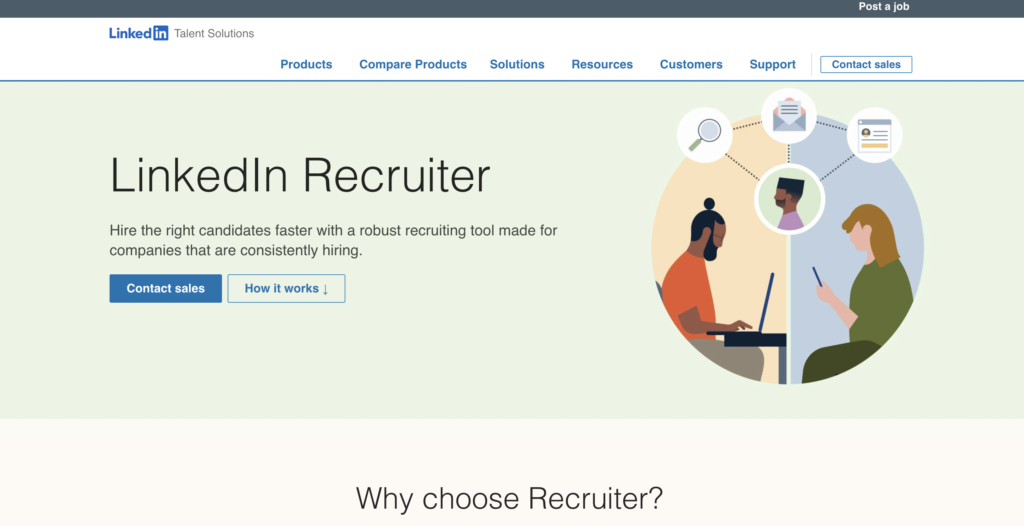
LinkedIn Recruiter is a powerful tool that can help organizations find and recruit top talent on the platform.
Here are some strategies to help you effectively use LinkedIn Recruiter:
- Utilize advanced search tools LinkedIn Recruiter offers advanced search tools that allow you to filter potential candidates based on a wide range of criteria, including job title, location, industry, and skills. By using these tools, you can identify potential candidates who match your ideal profile and are more likely to be a good fit for your organization.
- Personalize your outreach When reaching out to potential candidates on LinkedIn Recruiter, it’s important to personalize your message and demonstrate why your organization is a good fit for their career goals. Avoid generic messages and instead focus on highlighting specific aspects of the role or company that may be of interest to the candidate. Be sure to also follow up with candidates who express interest, even if they are not ready to apply immediately.
- Track candidate interactions LinkedIn Recruiter allows you to track candidate interactions, including when candidates view your profile or respond to your messages. By tracking these interactions, you can better understand how potential candidates are engaging with your organization and adjust your outreach strategy as needed.
- Collaborate with your team LinkedIn Recruiter allows you to collaborate with your team members, including sharing candidate profiles and notes. This can help you streamline your recruitment process and ensure that everyone is on the same page when it comes to potential candidates.
- Use analytics to measure success LinkedIn Recruiter offers analytics that allow you to measure the success of your recruitment efforts, including how many candidates you have contacted and how many have responded. Use these analytics to make informed decisions about your recruitment strategy and adjust your approach as needed.
While LinkedIn Recruiter does require a subscription fee, it can be a worthwhile investment for organizations looking to attract top talent.
By utilizing advanced search tools, personalizing your outreach, tracking candidate interactions, collaborating with your team, and using analytics to measure success, you can effectively use LinkedIn Recruiter to find and recruit the right candidates for your organization.
6. Leveraging Employee Networks

One of the most effective ways to find top talent on LinkedIn is to leverage the networks of your current employees.
Here are some strategies to help you effectively leverage employee networks on LinkedIn:
- Encourage employees to update their profiles Encourage your employees to update their LinkedIn profiles and ensure that they accurately reflect their current job titles and responsibilities. This will help potential candidates find your organization more easily and make it clear which employees are available for networking.
- Provide training and resources Provide training and resources to help your employees effectively use LinkedIn for networking and recruitment. This can include tips on how to build a strong profile, how to connect with potential candidates, and how to share job postings with their networks.
- Incentivize employee referrals Incentivizing employee referrals can be a highly effective way to find top talent on LinkedIn. Offer a referral bonus or other incentive to employees who refer candidates who are ultimately hired by your organization. This can motivate employees to actively seek out potential candidates in their networks.
- Share job postings with employees Share job postings with your employees and encourage them to share them with their networks. This can help spread the word about your open positions and reach a wider audience of potential candidates.
- Highlight employee success stories Highlighting employee success stories on LinkedIn can help attract top talent to your organization. Share stories of employees who have excelled in their roles and showcase how your organization supports employee growth and development.
By effectively leveraging the networks of your current employees on LinkedIn, you can tap into a highly talented pool of professionals who are already connected to your organization. Encouraging employees to update their profiles, providing training and resources, incentivizing employee referrals, sharing job postings with employees, and highlighting employee success stories can all help you find and attract the right candidates for your organization.
7. Showcasing Company Culture on LinkedIn
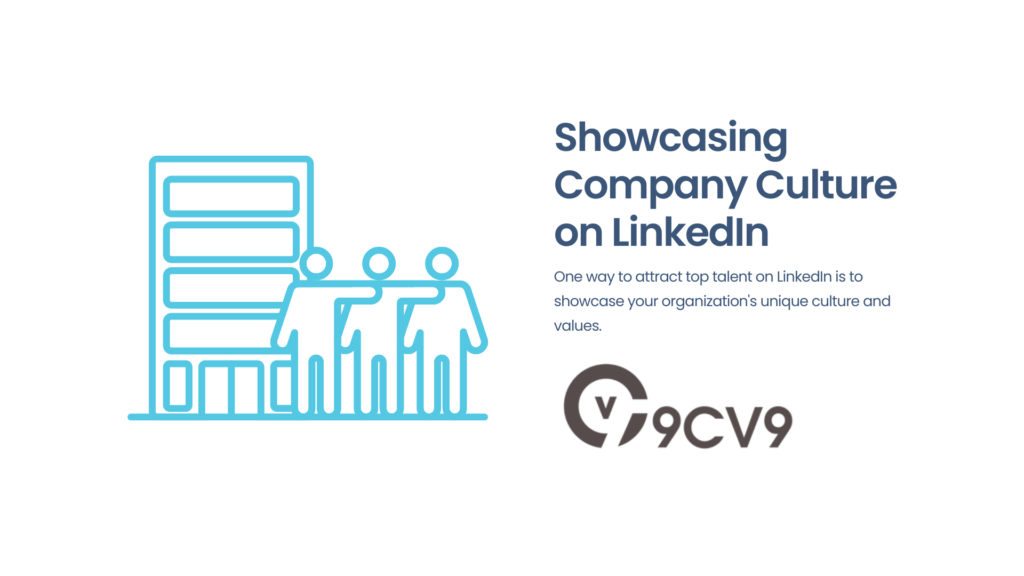
In today’s job market, candidates are increasingly looking for more than just a paycheck – they want to work for organizations that share their values and offer a positive company culture.
One way to attract top talent on LinkedIn is to showcase your organization’s unique culture and values.
Here are some strategies to help you effectively showcase company culture on LinkedIn:
- Share company updates and news Share updates and news about your organization on LinkedIn, including new product releases, community involvement, and employee accomplishments. This can help potential candidates get a better sense of what your organization stands for and the impact it is making in its industry.
- Highlight employee experiences Highlight the experiences of your current employees on LinkedIn, including success stories, company events, and team outings. This can help potential candidates see what it’s like to work at your organization and the opportunities for growth and development that are available.
- Showcase your company values Be transparent about your organization’s values and what it stands for. This can include highlighting any corporate social responsibility initiatives or charitable efforts that your organization supports. By showcasing your values, you can attract like-minded candidates who share your organization’s beliefs.
- Use multimedia content Use multimedia content on LinkedIn to showcase your company culture, including photos and videos of employees at work and company events. This can help potential candidates get a better sense of what it’s like to work at your organization and the positive culture that you offer.
- Engage with followers Engage with your followers on LinkedIn by responding to comments and sharing content from other organizations and thought leaders in your industry. This can help you build a strong community on LinkedIn and attract potential candidates who are interested in your organization’s culture and values.
By effectively showcasing your organization’s unique culture and values on LinkedIn, you can attract top talent who are aligned with your mission and vision.
Sharing company updates and news, highlighting employee experiences, showcasing your company values, using multimedia content, and engaging with followers can all help you build a strong presence on LinkedIn and attract the right candidates for your organization.
8. Tracking and Measuring Success
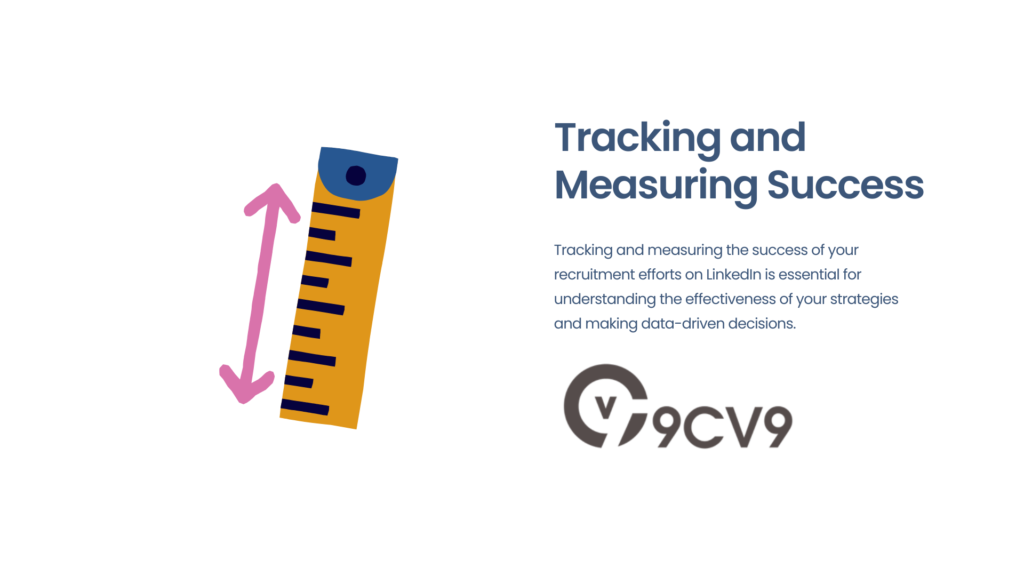
Tracking and measuring the success of your recruitment efforts on LinkedIn is essential for understanding the effectiveness of your strategies and making data-driven decisions.
Here are some key metrics to track and strategies for measuring success:
- Candidate sourcing metrics Track the number of candidates who apply or express interest in a position through LinkedIn, as well as the quality of those candidates. This can help you understand the effectiveness of your job postings and outreach efforts.
- Engagement metrics Track engagement metrics such as the number of views, likes, and comments on your LinkedIn posts. This can help you understand which types of content resonate with your audience and adjust your strategies accordingly.
- Referral metrics Track the number of referrals that come from your employees’ networks on LinkedIn. This can help you understand the effectiveness of your employee referral program and adjust incentives as needed.
- Time-to-hire metrics Track the time it takes to fill positions sourced through LinkedIn. This can help you identify any bottlenecks in your recruitment process and make adjustments to improve efficiency.
- Diversity metrics Track diversity metrics such as the number of candidates from underrepresented groups who apply or are hired through LinkedIn. This can help you understand the effectiveness of your diversity and inclusion efforts and identify areas for improvement.
In addition to tracking these metrics, it’s important to establish goals and benchmarks for success.
For example, you may set a goal of increasing the number of applications sourced through LinkedIn by a certain percentage within a given timeframe.
Regularly reviewing your progress towards these goals and adjusting your strategies accordingly can help you continuously improve the effectiveness of your recruitment efforts on LinkedIn.
It’s also important to regularly gather feedback from candidates and employees to understand their experiences with your organization’s recruitment process on LinkedIn.
This can help you identify areas for improvement and ensure that your strategies are aligned with the needs and preferences of your target audience.
By tracking and measuring the success of your recruitment efforts on LinkedIn, you can make data-driven decisions that lead to more effective and efficient recruitment strategies.
Monitoring candidate sourcing, engagement, referrals, time-to-hire, and diversity metrics, establishing goals and benchmarks, gathering feedback, and making continuous improvements can help you stay competitive in today’s job market and attract top talent to your organization.
9. Understanding your Competitors
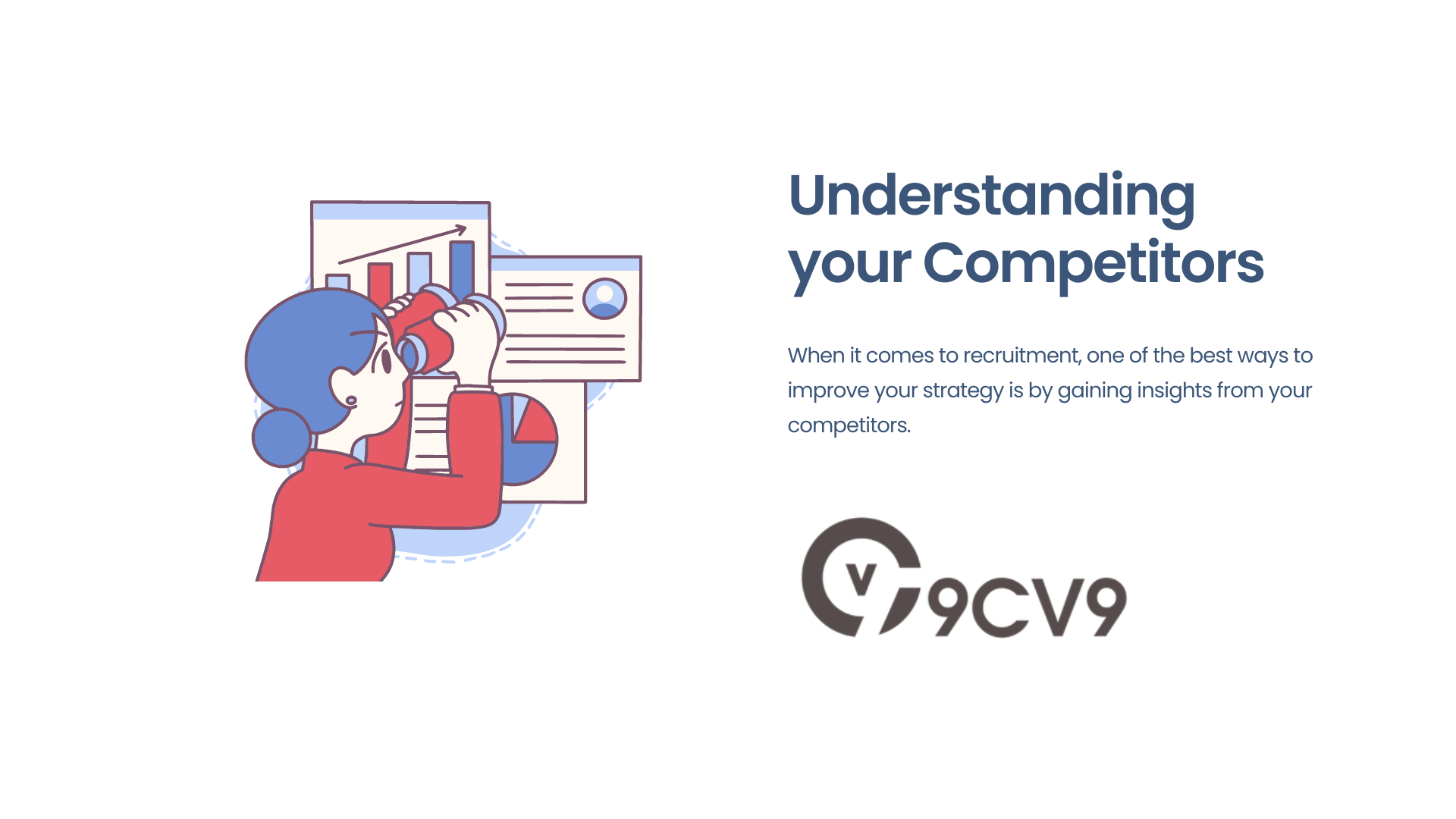
When it comes to recruitment, one of the best ways to improve your strategy is by gaining insights from your competitors.
This is especially true on LinkedIn, where many companies are vying for top talent.
Here are some strategies for gaining insights from competitor companies on LinkedIn:
- Follow their company page: Following your competitors’ company pages on LinkedIn can provide valuable insights into their recruitment efforts. You can see the types of content they are posting, the engagement they are receiving, and the types of candidates they are targeting.
- Analyze their job postings: Take a close look at your competitors’ job postings on LinkedIn. This can help you understand the types of skills and experience they are looking for in candidates, as well as the language they are using to describe their open positions.
- Look at their employee profiles: Check out the LinkedIn profiles of your competitors’ employees. This can give you an idea of the types of candidates they are hiring, as well as the skills and experience they value.
- Monitor their activity: Keep an eye on your competitors’ activity on LinkedIn. This includes things like their engagement with other users, the types of content they are sharing, and the groups they are participating in. This can help you understand their overall approach to recruitment on the platform.
- Use LinkedIn’s analytics tools: LinkedIn offers a range of analytics tools that can help you gain insights into your competitors’ recruitment efforts. For example, Talent Insights can provide data on the types of candidates your competitors are hiring, while Job Posts Analytics can show you the performance of their job postings.
By gaining insights from your competitors, you can improve your recruitment strategy and stay ahead of the competition on LinkedIn.
However, it’s important to keep in mind that while it’s helpful to learn from others, you should also strive to create a unique and authentic brand that sets you apart from the crowd.
10. Use Boolean Search to Find Candidate LinkedIn Profiles
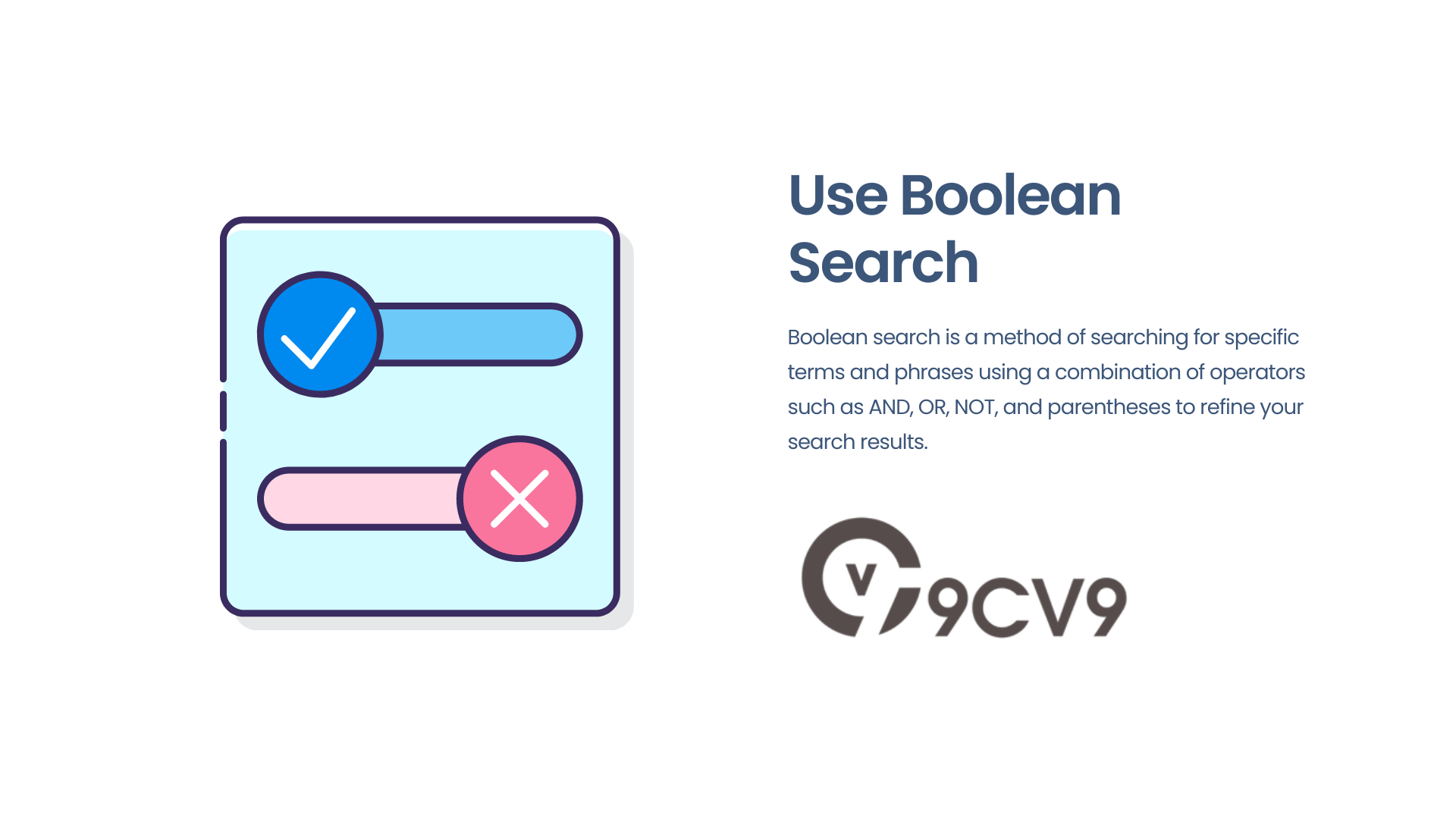
One of the most effective ways to find potential candidates on LinkedIn is by using Boolean search.
Boolean search is a method of searching for specific terms and phrases using a combination of operators such as AND, OR, NOT, and parentheses to refine your search results.
This method can help you find profiles that match specific job titles, skills, and experience levels.
Here are some tips for using Boolean search to find candidate LinkedIn profiles:
- Identify the keywords and phrases: Start by identifying the keywords and phrases that are relevant to the position you are trying to fill. For example, if you are looking for a marketing manager, some relevant keywords might include “marketing,” “manager,” “social media,” “campaigns,” and “analytics.”
- Use Boolean operators: Use Boolean operators such as AND, OR, and NOT to refine your search results. For example, you could search for “marketing manager” AND “social media” to find profiles that mention both of those keywords.
- Use parentheses: Use parentheses to group related terms together. For example, you could search for “(marketing OR advertising) AND manager” to find profiles that mention either marketing or advertising and the word manager.
- Use quotation marks: Use quotation marks to search for an exact phrase. For example, you could search for “digital marketing manager” to find profiles that mention that exact phrase.
- Use LinkedIn’s search filters: LinkedIn also offers a range of search filters that can help you refine your results. For example, you can filter by location, industry, and job function to find candidates who meet your specific requirements.
Using Boolean search can help you find highly qualified candidates who may not appear in a standard keyword search.
By refining your search terms and using Boolean operators, you can target the most relevant profiles and save time in the recruitment process.
However, it’s important to remember that Boolean search is just one tool in your recruitment arsenal, and should be used in conjunction with other strategies such as networking, employee referrals, and job postings.
Conclusion
In today’s competitive job market, recruiters need to leverage every available tool to attract and retain top talent. LinkedIn provides an invaluable platform for recruitment, with over 740 million members and a suite of powerful features designed specifically for hiring professionals.
In this article, we’ve outlined 10 top strategies for recruiting on LinkedIn, including optimizing your profile, posting job openings, utilizing LinkedIn Groups, recruiting passive candidates, using LinkedIn Recruiter, leveraging employee networks, showcasing company culture, and tracking and measuring success.
By following these strategies, recruiters can create a strong presence on LinkedIn and connect with a wide range of talented candidates. Whether you’re looking to fill a specific role or build a pipeline of potential candidates for future positions, these strategies can help you attract the right people to your organization.
However, it’s important to remember that recruiting on LinkedIn is not a one-size-fits-all solution. It’s essential to tailor your approach to your organization’s unique needs and goals, and regularly assess and adjust your strategies based on feedback and data.
In addition, it’s important to prioritize building authentic relationships with candidates and employees on LinkedIn. By providing value and building trust with your network, you can attract top talent and create a strong employer brand that sets your organization apart.
In conclusion, LinkedIn is a powerful tool for recruiting that offers a wide range of features and strategies for hiring professionals. By leveraging these strategies and staying up-to-date on the latest trends and best practices, recruiters can attract and retain top talent and build a competitive advantage in today’s job market.
If you find this article useful, why not share it among your Recruiter friends, and also leave a nice comment below?
We at the Jobsrefer Research Team strive to bring the latest and most meaningful data, guide, and statistics to your doorstep.




